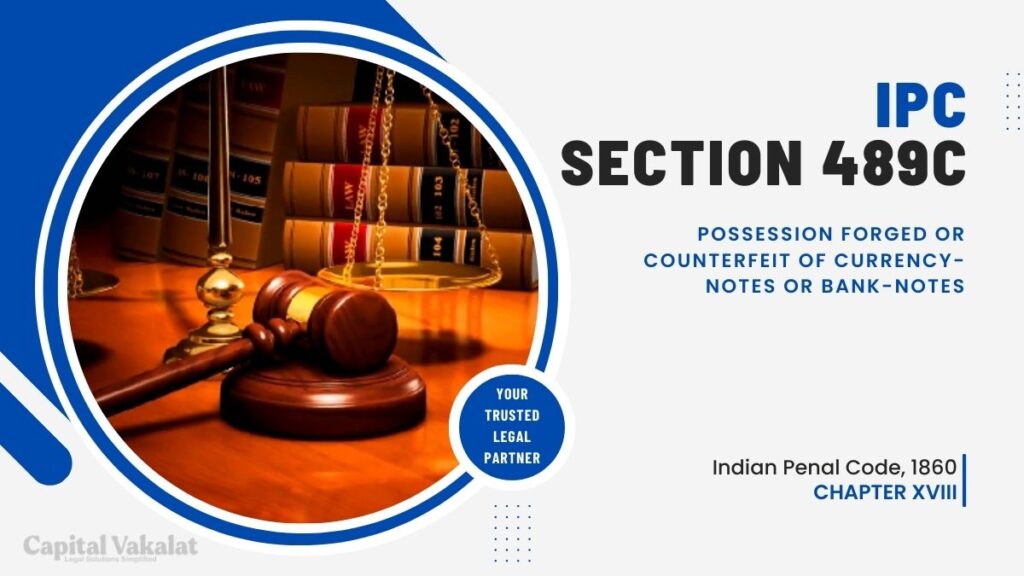Counterfeiting currency is a crime that strikes at the heart of a nation’s economic stability and integrity. Section 489C of the Indian Penal Code (IPC) addresses the possession of forged or counterfeit currency-notes or bank-notes.

This article explores the intricacies of Section 489C, delving into its definition, historical context, legal consequences, prevention measures, and its impact on the economy.
Introduction to Section 489C IPC
Counterfeit currency poses a significant threat to the financial well-being of a nation. Section 489C IPC plays a crucial role in combating this menace. Understanding the implications of this section is not only essential for legal professionals but also for the general public.
Definition and Scope of Section 489C IPC
Section 489C IPC explicitly addresses the act of possessing forged or counterfeit currency-notes or bank-notes. This section aims to outline the legal consequences individuals face when found in possession of such deceptive currency. The article will delve into the intricacies of this section, emphasizing the gravity of the offense and the penalties involved.
History of Counterfeiting Currency
To comprehend the gravity of Section 489C IPC, it’s crucial to explore the historical context of counterfeiting currency. From ancient times to modern-day sophisticated methods, the article will shed light on the evolution of this illicit practice, citing notable historical incidents that shaped the current legal framework.
Key Elements of Section 489C IPC
This section will break down the key elements of Section 489C, explaining what constitutes possession of counterfeit currency. Differentiating between forged and genuine currency, understanding the requisite intent, and knowledge of possession are essential aspects that will be thoroughly discussed.
Legal Consequences
The article will outline the severe legal consequences individuals face when found guilty under Section 489C IPC. Real-life case studies will be examined to illustrate the gravity of the offense and the corresponding legal outcomes.
Prevention and Detection Measures
Preventing the circulation of counterfeit currency is a collective effort that involves law enforcement agencies and advancements in technology. This section will explore the measures taken by authorities to detect and prevent the spread of counterfeit currency, highlighting technological advancements in currency authentication.
Impact on the Economy
Counterfeit currency not only undermines the financial system but also has far-reaching consequences on the economy. This part of the article will discuss the economic ramifications of counterfeit currency and the measures governments take to safeguard their economies from such threats.
Public Awareness and Education
Creating awareness among the public is a crucial step in combating counterfeiting. The article will emphasize the importance of educating individuals on how to identify counterfeit currency, providing practical tips to stay vigilant in everyday transactions.
Global Perspective
To provide a comprehensive view, this section will explore how other countries address the possession of counterfeit currency. It will also delve into collaborative efforts on a global scale to combat counterfeiting and protect the integrity of international currencies.
In the concluding section, a recap of key points will reinforce the significance of understanding Section 489C IPC. A call to action for increased awareness and vigilance will be made, urging both individuals and authorities to play an active role in preventing the circulation of counterfeit currency.
Conclusion
In conclusion, Section 489C IPC serves as a bulwark against the detrimental effects of possessing forged or counterfeit currency. The article has explored the historical context, legal implications, prevention measures, and the global perspective on combating counterfeit currency. It is imperative for individuals and society as a whole to comprehend the gravity of this offense and actively contribute to its prevention.
Frequently Asked Questions
What penalties do individuals face under Section 489C IPC?
Violators can face imprisonment and fines, the severity of which depends on the quantity of counterfeit currency involved.
Are there any technological advancements in detecting counterfeit currency?
Yes, advancements such as UV detection and magnetic ink sensors are used to identify counterfeit currency.
How can public awareness help combat counterfeiting?
Public awareness plays a crucial role in preventing the circulation of counterfeit currency by promoting vigilance and reporting suspicious transactions.
Is counterfeiting currency a global issue?
Yes, counterfeiting is a global problem, and countries collaborate to share intelligence and combat this threat collectively.